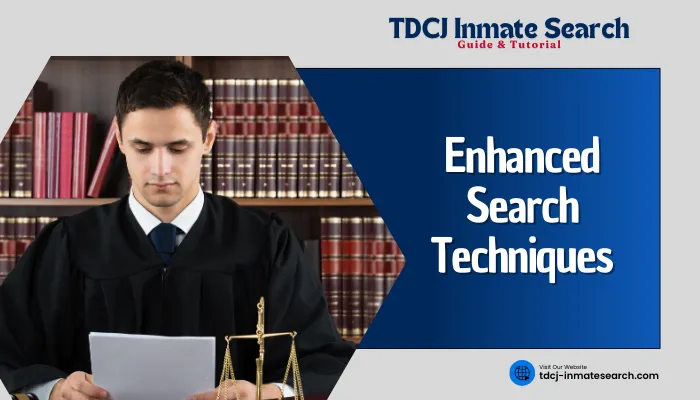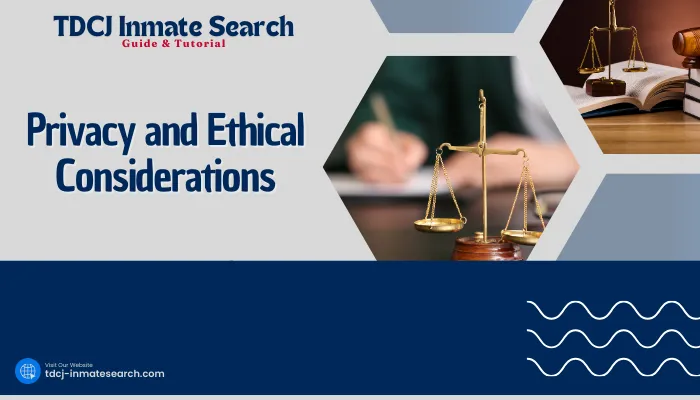The former TDCJ Inmate Search is an important means of finding information about individuals who have been imprisoned in Texas before. Consequently, The Texas Department of Criminal Justice (TDCJ) provides this service, which enables access to records and data concerning former prisoners.

The search platform is easy to use and has a wide range of data that can be helpful when you want to reconnect with people who were imprisoned in the past or verify some details or even conduct background checks.
With accurate and up-to-date records, the old TDCJ Inmate Search ensures transparency and accessibility, making it an essential resource for anyone needing information about former inmates in Texas.
This article explains how a past TDCJ prisoner search is conducted by looking into techniques employed, associated benefits as well as considerations involved therein.

Former TDCJ Inmate Search by Number
But before we delve into the complexities of searching for former TDCJ inmate search, let’s first understand what constitutes a TDCJ number and why it is so significant within the Texan criminal justice system.
What’s A TDCJ Number?
A unique number given to every person entering the Texas Department of Criminal Justice system is known as a TDCJ number also referred to as State ID (SID) number. It performs several functions:
1. Identification – This provides continuity in terms of identifying an offender throughout their time within the system. 2. Record Keeping – The TDCJ number serves as a reference point in maintaining accurate inmate history including convictions, sentences, and release dates. 3. Facilitation of Searching: Easy retrieval for both official and public purposes when facilitating searches on inmates.
How TDCJ Numbers are Assigned
Sequentially through entry into the system are how these numbers are assigned by law enforcement agencies. Here’s an outline on how this process happens:
- Initial Booking: At their initial booking into any facility under the purview of TDCJ, each individual is assigned a unique TDCJ number.
- Permanence: After being first assigned, this number stays with the person for life even upon release or subsequent reincarceration.
- Format: Typically, TDCJ numbers contain 7 or 8 digits and do not have any letters or special characters.
When you understand how the assignment of TDCJ numbers is done in Texas’ criminal justice system, it becomes clear how identification works. These unique, permanent numbers ensure accurate record-keeping and facilitate efficient information retrieval.
Importance of Former TDCJ Inmate Search
There are several purposes why one would carry out a search about former TDCJ inmate search. Some of the main reasons behind these searches are as follows:
1. Public Safety
- Awareness: Communities can be kept informed about possible dangers by knowing where former prisoners reside.
- Victim Notification: Victims of crimes can keep track of their offenders’ release status.
2. Background Checks
- Employment Screening: Sometimes employers may need to corroborate an applicant’s criminal history.
- Housing Applications: Landlords might conduct searches to assess potential tenants.
3. Legal Purposes
- Court Proceedings: Attorneys may need to locate former inmates for legal matters.
- Probation/Parole: Officials might track former inmates to ensure compliance with release conditions.
4. Personal Reasons
- Family Reconnection: Relatives may seek information about incarcerated family members.
- Research: Journalists or academics might use the search for investigative or scholarly purposes.
Methods for Conducting a Former TDCJ Inmate Search
Having established the significance of such searches, let us look at some ways through which searchers can carry out a previous inmate search in TDCJ.
Online TDCJ Offender Search
When you are trying to conduct a former TDCJ inmate search, the most suitable way is through TDCJ’s official website. Here is how you can go about using this online tool step by step:
- Visit the TDCJ Website: The Official TDCJ Offender Information Search page is where you should navigate.
- Enter Search Criteria: What you need to do here is just key in the former offender’s TDCJ number.
- Submit Search: Clicking on the search button will provide information pertaining to the incarcerated person.
- Review Results: The returned information might include:
- Current status (incarcerated, released, paroled)
- Personal details (name, date of birth, gender)
- Offense information
- Sentence details
- Release date (if applicable)
The use of online TDCJ Offender Search provides an easy and efficient way to find comprehensive information on formerly incarcerated persons quickly and accurately.
Phone Inquiry
People who don’t have access to the internet or prefer verbal communication can still get help from Texas Department of Criminal Justice through phone services offered by them:
- Call the TDCJ Information Center: Dial (936) 295-6371.
- Provide TDCJ Number: When prompted just put in the TDCJ number for that previous inmate.
- Listen to Information: The automated system will give information available about the offender.
TDCJ phone inquiry saves time and effort particularly for those who cannot afford internet services.
Mail Request
Additional information or when one cannot access online or use the phone may be obtained in case of a mail request:
- Write a Letter: Compose a letter including name in full of the former prisoner and their TDCJ Number.
- Address the Letter: Texas Department of Criminal Justice
P.O Box 99
Huntsville, TX 77342-0099 - Wait for Response: Processing and return mail take a few weeks.
TDCJ mail request is another way of getting detailed information mainly to individuals who prefer traditional ways of communication.
In-Person Inquiry
People living in proximity to TDCJ facilities can get help through inquiry in person:
- Visit a TDCJ Unit: Find the closest TDCJ facility.
- Speak with Staff: Ask for guidance from the information desk.
- Provide TDCJ Number: Give the staff member the inmate’s former TDCJ number.
Visiting a TDCJ unit for face-to-face inquiries comes with a unique, personal experience of interacting with the staff attending to former inmates.

Enhanced Search Techniques
Basic search methods work but there are more advanced techniques that make searching for your former inmate in the Texas Department of Criminal Justice database much easier.
1. Utilizing Multiple Identifiers
When conducting a search, using multiple identifiers can significantly increase the chances of finding the correct information:
Combine TDCJ Number with Name: Including full name alongside an inmate’s ID number might be helpful even if you already have their TDCJ number.
Date of Birth: This helps distinguish between people with similar names.
Last Known Facility: Adding this can narrow down search results by last place known to house that offender.
2. Historical Records Search
For inmates released many years ago, consider exploring historical records:
Texas State Archives: They maintain older records that may not be available on the current online system.
County Records: Look at the conviction county for more details.
3. Utilizing Social Media
Though not an official way, social media may provide extra details:
LinkedIn: Some ex-prisoners may put their record of imprisonment in their profiles.
Facebook groups: There are many groups that are dedicated to connecting ex-inmates and their families.
Decoding Search Results
Understanding the information given in search results is essential:
1. Codes of Status
TDCJ uses various codes to indicate an inmate’s status. There are some common ones including:
- TR: Temporarily Released
- PR: Parole Release
- DR: Discharge Release
- DC: Death in Custody
2. Offense Codes
Each offense has an associated code number. Familiarizing yourself with these codes will help you quickly understand the nature of the crime:
- BU: Burglary
- RO: Robbery
- SA: Sexual Assault
- MU: Murder
3. Designations of Units
Different designations are used for TDCJ facilities. It is good to know them so as to understand where a prisoner was held until he or she left for another facility:
- HU: Huntsville Unit
- PO: Polunsky Unit
- ES: Estelle Unit
Understanding these codes of status, offense codes, and designations of units is crucial for effectively navigating and interpreting information from the TDCJ system. By familiarizing yourself with these details, you can more accurately track and understand an inmate’s history and current status.
Best Practices for Regular Searches
For people who perform frequent former TDCJ inmate search, here are some tips:
- Create a Search Log: Maintain a spreadsheet that contains your search criteria and results so that you can reference it easily.
- Set Up Alerts: Some external services allow you to receive email updates when there’s a change in an inmate’s status.
- Use Consistent Search Criteria: You should standardize your approach to searching so that your results will be uniform across all your searches.
- Cross Reference Multiple Sources: TDCJ data can be compared with other public records to create a holistic picture.
By incorporating such progressive methods and practices, searchers may enhance their old offender TDCJ, hence better performance and complete answers obtained.
Challenges in Former TDCJ Inmate Search
Though relatively simple, there might be difficulties behind conducting former TDCJ inmate search, these challenges include:
| Challenge | Solution |
|---|---|
| Incorrect TDCJ Number | – Recheck the number for accuracy. – Search by name instead. |
| Limited Information Access | – Some information may be restricted due to privacy laws. – Make a formal request for more detailed information. |
| Outdated Records | – Records might not be updated immediately upon release. – Call TDCJ directly to get the most current details. |
| Name Changes | – If an inmate has changed names, it is more reliable to search using the inmate’s TDCJ number. |
| Technical Issues | – In case the online system crashes, try other means like calling or mailing. |
While challenges may arise in a former TDCJ inmate search, these tips can help ensure you obtain the most accurate and current information available.

Privacy and Ethical Considerations
When conducting a former TDCJ inmate search, it is important to consider ethics and respect for privacy. Here are some important points to keep in mind:
Balancing Public Safety and Individual Privacy
- Public Record: Generally, inmate information is considered as public record.
- Limited Disclosure: Only some parts of the information are made available publicly.
Responsible Use of Information
- Avoid Discrimination: Do not misuse these records in order to discriminate unfairly against ex-prisoners.
- Verification: Always cross check information obtained through searches.
Legal Restrictions
- Fair Credit Reporting Act (FCRA): Regulates employment use of criminal records.
- State Laws: Texas might also have additional specific statutes restricting use of criminal record data.
Understanding privacy and ethical considerations is essential when conducting a former TDCJ inmate search. Always balance public safety with respect for individual privacy and comply with legal restrictions.
Challenges in Former TDCJ Inmate Search
The world of offender information systems is changing with technology. The next developments in former TDCJ inmate search may include:
- Enhanced Digital Integration
- Mobile Apps: Specific applications for mobile searching to make it easier.
- API Access: Linking other criminal justice databases.
- Improved Data Accuracy
- Real-time Updates: Synchronizing inmate status changes more quickly.
- Blockchain Technology: Safer and more genuine records.
- Expanded Search Criteria
- Biometric Data: Possibility of using fingerprints or other types of biometrics.
- Geographic Mapping: Showing the locations of offenders after they are released.
- Artificial Intelligence Assistance
- Predictive Analytics: AI-based understanding on recidivism risks.
- Natural Language Processing: More user-friendly search interfaces for inmates.
Advancements in technology have made the future outlook of TDCJ’s former inmate searches promising as far as better accuracy, integration, and user-friendliness. These advances will make it easier for people to access information while ensuring that confidentiality issues are well taken into account.
Comparative Analysis: TDCJ vs. Other State Systems
In this comparison, we shall look at the former TDCJ Inmate search system alongside those of major states like:
| State | Online Search | Phone Search | Mail Request | Unique Features |
|---|---|---|---|---|
| Texas (TDCJ) | Yes | Yes | Yes | Comprehensive offense history |
| California | Yes | Yes | Yes | Inmate locator map |
| Florida | Yes | No | Yes | Near-real-time updates |
| New York | Yes | Yes | Yes | Multiple language support |
Conclusion
A former TDCJ inmate search is a powerful tool that serves multiple purposes such as enhancing public safety, facilitating background checks, or personal inquiries. Knowing the available methods, possible barriers, and ethical considerations helps one to use this valuable resource responsibly.
This search has the potential to become even more efficient and comprehensive in future thanks to technological advancements. However, it is essential to strike a balance between information needs and individual privacy rights or possibilities for recovery after incarceration.
The system will be essential for anyone concerned about security of their communities, employers needing background checks, or someone seeking information for personal reasons. By following the suggestions presented in this article, you will be able to successfully and ethically navigate your way through finding ex-inmates from TDCJ.
Do not forget that life after prison can be hard. While access to information is crucial, there is a need to support rehabilitation processes and allow individuals to come back to society fitly.
Contents
- Former TDCJ Inmate Search by Number
- Importance of Former TDCJ Inmate Search
- Methods for Conducting a Former TDCJ Inmate Search
- Enhanced Search Techniques
- Decoding Search Results
- Best Practices for Regular Searches
- Challenges in Former TDCJ Inmate Search
- Privacy and Ethical Considerations
- Challenges in Former TDCJ Inmate Search
- Comparative Analysis: TDCJ vs. Other State Systems
- Conclusion
